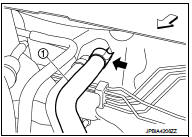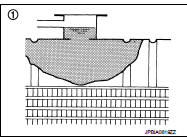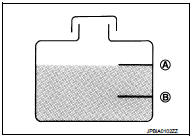Nissan Juke Service and Repair Manual : Refilling
1. Install reservoir tank if removed and radiator drain plug.
CAUTION:
Be sure to clean drain plug and install with new O-ring.
Radiator drain plug : Refer to CO-42, "Exploded View".
• If water drain plugs on cylinder block are removed, close and tighten them. Refer to EM-228, "Disassembly and Assembly".
2. Check that each hose clamp has been firmly tightened.
3. Remove air duct (between air cleaner case and electric throttle control actuator). Refer to EM-161, "Exploded View".
4. Disconnect heater hose (1) at position (
) in the figure.
 : Vehicle front
: Vehicle front
• Enhance heater hose as high as possible.

5. Fill radiator (1) to specified level.
CAUTION:
Never adhere the engine coolant to electronic equipments
(alternator etc.).
• Pour coolant slowly of less than 2 (2-1/8 US qt, 1-3/4 Imp qt) a minute to allow air in system to escape.
• When engine coolant overflows disconnected heater hose, connect heater hose, and continue filling the engine coolant.
• Use Genuine NISSAN Engine Coolant or equivalent in its quality mixed with water (distilled or demineralized). Refer to MA-13, "Fluids and Lubricants".
Engine coolant capacity (With reservoir tank at “MAX” level) Refer to CO-54, "Periodical Maintenance Specification".

6. Refill reservoir tank to “MAX” level line with engine coolant.
A : MAX
B : MIN
Reservoir tank engine coolant capacity
(At “MAX” level)
Refer to CO-54, "Periodical Maintenance Specification".

7. Install air duct (between air cleaner case and electric throttle control actuator). Refer to EM-161, "Exploded View".
8. Install radiator cap.
9. Warm up engine until opening thermostat. Standard for warming-up time is approximately 10 minutes at 3,000 rpm.
• Check thermostat opening condition by touching radiator hose (lower) to see a flow of warm water.
CAUTION:
Watch water temperature gauge so as not to overheat engine
.
10. Stop the engine and cool down to less than approximately 50°C (122°F).
• Cool down using fan to reduce the time.
• If necessary, refill radiator up to filler neck with engine coolant.
CAUTION:
Never adhere the engine coolant to electronic equipments (alternator etc.).
11. Refill reservoir tank to “MAX” level line with engine coolant.
12. Repeat steps 5 through 10 two or more times with radiator cap installed until engine coolant level no longer drops.
13. Check cooling system for leakage with engine running.
14. Warm up the engine, and check for sound of engine coolant flow while running engine from idle up to 3,000 rpm with heater temperature controller set at several position between “COOL” and “WARM”.
• Sound may be noticeable at heater unit.
15. Repeat step 14 three times.
16. If sound is heard, bleed air from cooling system by repeating step 5 through 10 until reservoir tank level no longer drops.
 Draining
Draining
WARNING:
• Never remove radiator cap when engine is hot. Serious burns may occur from
high-pressure engine
coolant escaping from radiator.
• Wrap a thick cloth around the radiator cap. Slowly tur ...
 Flushing
Flushing
1. Install reservoir tank if removed and radiator drain plug.
CAUTION:
Be sure to clean drain plug and install with new O-ring.
Radiator drain plug : Refer to CO-42, "Exploded View".
• ...
Other materials:
Emission control system warranty
Your NISSAN is covered by the following emission warranties.
For USA:
• Emission Defects Warranty
• Emissions Performance Warranty
Details of these warranties may be found with other vehicle warranties in your
Warranty Information Booklet which comes with your NISSAN. If you did no ...
B1153 curtain air bag module LH
DTC Logic
DTC DETECTION LOGIC
DTC CONFIRMATION PROCEDURE
1.CHECK SELF-DIAG RESULT
With CONSULT-III
1. Turn ignition switch ON.
2. Perform “Self Diagnostic Result” mode of “AIR BAG” using CONSULT-III.
Without CONSULT-III
1. Turn ignition switch ON.
2. Check the air bag warning lamp statu ...
P1715 input speed sensor
Description
ECM receives input speed sensor signal from TCM via the CAN communication
line. ECM uses this signal for
engine control.
DTC Logic
DTC DETECTION LOGIC
NOTE:
• If DTC P1715 is displayed with DTC UXXXX, first perform the trouble diagnosis
for DTC UXXXX.
• If DTC P1715 is display ...
